Europe has been trapped under a long-lasting heat dome this summer, extending and significantly worsening the already severe and persistent drought across many parts of the continent. The drought is at an exceptional level since late June, with extreme heat exceeding 40 °C. Weeks, even months of no significant rain in some areas have resulted in large wildfires.
Recently, a historic wildfire developed in the Karst region, along the border between Italy and Slovenia. Becoming the largest on record for the country.

First estimates and satellite analysis reveal extensively burned areas, exceeding 3500 hectares. The first wildfire, which started on July 17th between towns Rence and Kostanjevica na Krasu, was followed by another wildfire starting on the Italian side of the border.
The ongoing heatwave with strong winds then rapidly spread the fire over the Karst in the following days.

Dramatic pictures from both day and night active firefront reveal how extensive and life-threatening wildfires can be. Thousands of firefighters, with help of helicopters and Canadair planes, are battling the uncontrolled fire, saving numerous villages and small towns in the region.
This wildfire has spread across both countries, Slovenia and Italy, thanks to daytime and nighttime-driven winds, well-known in the region. Overnight, winds are blowing roughly from east to west, and from west to east during the day. Thus, helping the fire to spread much faster as daytime westerly winds are stronger, pushing the firefront towards the east.

Photograph by Marko Korošec
While these winds are normal daytime occurrences over the Karst, they have been enhanced to some extent due to the ongoing extreme heatwave. The heatwave, that has gradually spread east from beneath the large, persistent heat dome formed over the west-southwest Europe, is helping to dry the land, even more, worsening the ongoing exceptional drought conditions.
WHAT IS A HEAT DOME AND HOW DOES IT FORM
We often hear the term Heat Dome in our discussions about extreme and record-breaking heatwaves in Europe or globally. This feature is actually the main background reason why extremely intense heatwave events developed in Europe this summer of 2022. The heat dome was the dominant large-scale feature last year in both continents, Europe and North America. Below is an example of the early July 2022 event over Europe, forming over the western part of Europe.
This was the historic heatwave that brought to the 40 °C mark for the first time on record in England (London Heathrow airport).
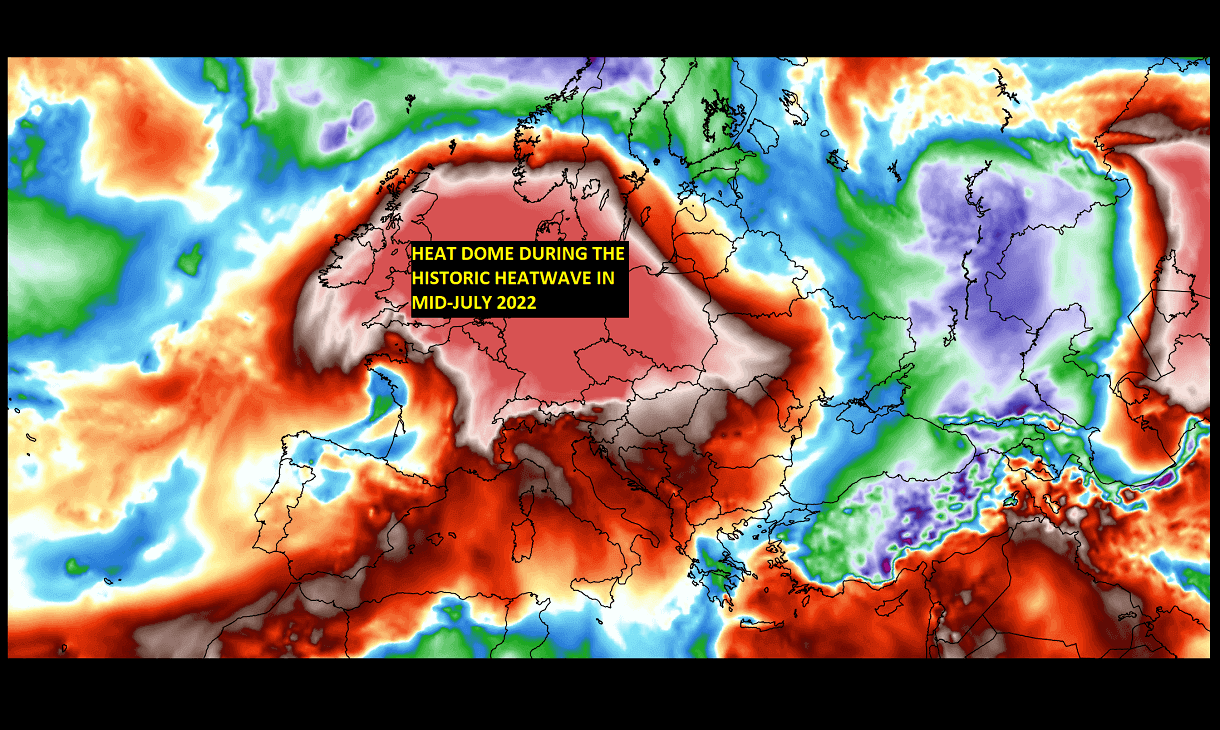
Speaking on a large scale, the heat dome forms when an upper-level ridge pattern develops, known as the blocking High. When this occurs, the blocking pattern brings very high, sometimes record-challenging temperatures for the land underneath. The air masses are trapped under the dome, leading to overheating effect. It also does not matter in which season it develops, these events can happen even during winter and work both ways, into very cold or very warm temperatures.
We use the term *heat dome* when a large area of high-pressure parks over a large portion of the continent. It normally stays there for several consecutive days or even weeks, bringing stable weather. These events are more intense and persistent, especially during the summer and winter months.
The general explanation of this is quite simple; we can imagine that the heat dome works like a lid on a pot, literally. The large dome sits over the continent, trapping a very warm air mass at all levels across a large area underneath. It is usually better defined at the lowest elevations where we live. Through its period of strengthening and persistence, the heat dome leads to overheating air mass as mixing air is lacking.
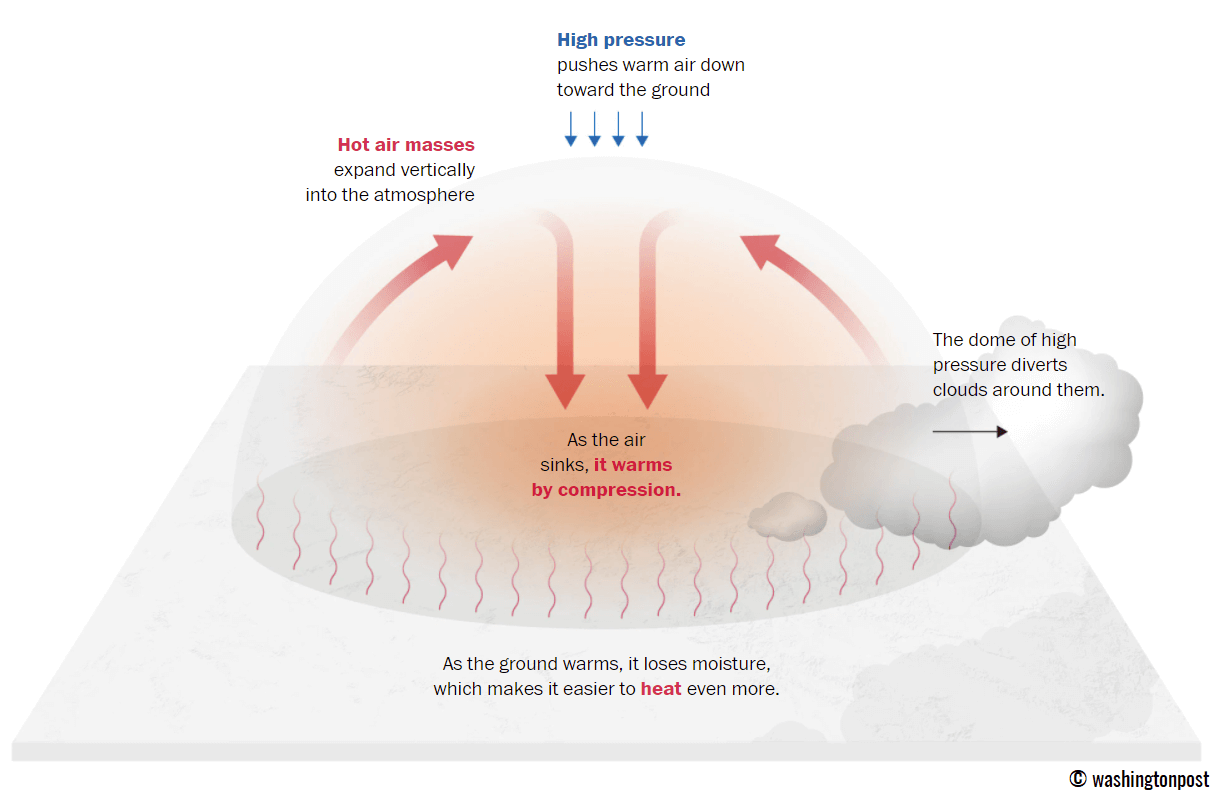
A heat dome is therefore known to create stable weather and often also very dry air mass due to subsidence (subsiding air mass) in its center. Domes bring very low chances for precipitation, not even clouds or fronts moving across. Air parcels in the center of the heat dome are sinking toward to ground.
A heat dome is often blamed to deliver deadly heatwave events around the world. Besides this, it often also leads to a significantly enhanced wildfire threat, especially during the summer months when temperatures are the highest. The daily maximum and average temperatures under the heat dome end up well above normal, challenging the existing records.
As mentioned earlier, the heat dome from western Europe has gradually spread towards central Europe through early July, worsening the ongoing exceptional drought with more dry air and more heatwave events.
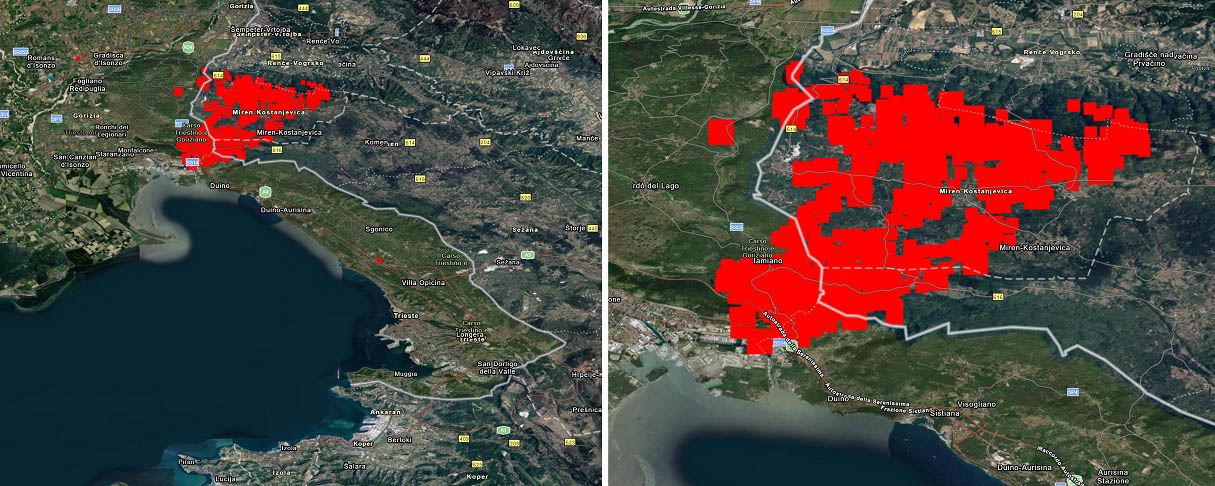
The worst has become across northern Italy and western Slovenia, precisely the Karst region where wildfires literally exploded on July 13th.
KARST PLATEAU REGION
The Karst Plateau is a karst plateau region extending across the border of southwestern Slovenia and northeastern Italy. One disadvantage of the region is the lack of surface water. The soils are fertile enough, and even though there’s quite high rainfall amount annually, rainwater quickly moves through the crevices into the deep ground. Therefore, the surface rapidly dries out during heatwaves and summer months. Leading to the worst drought conditions in the region.
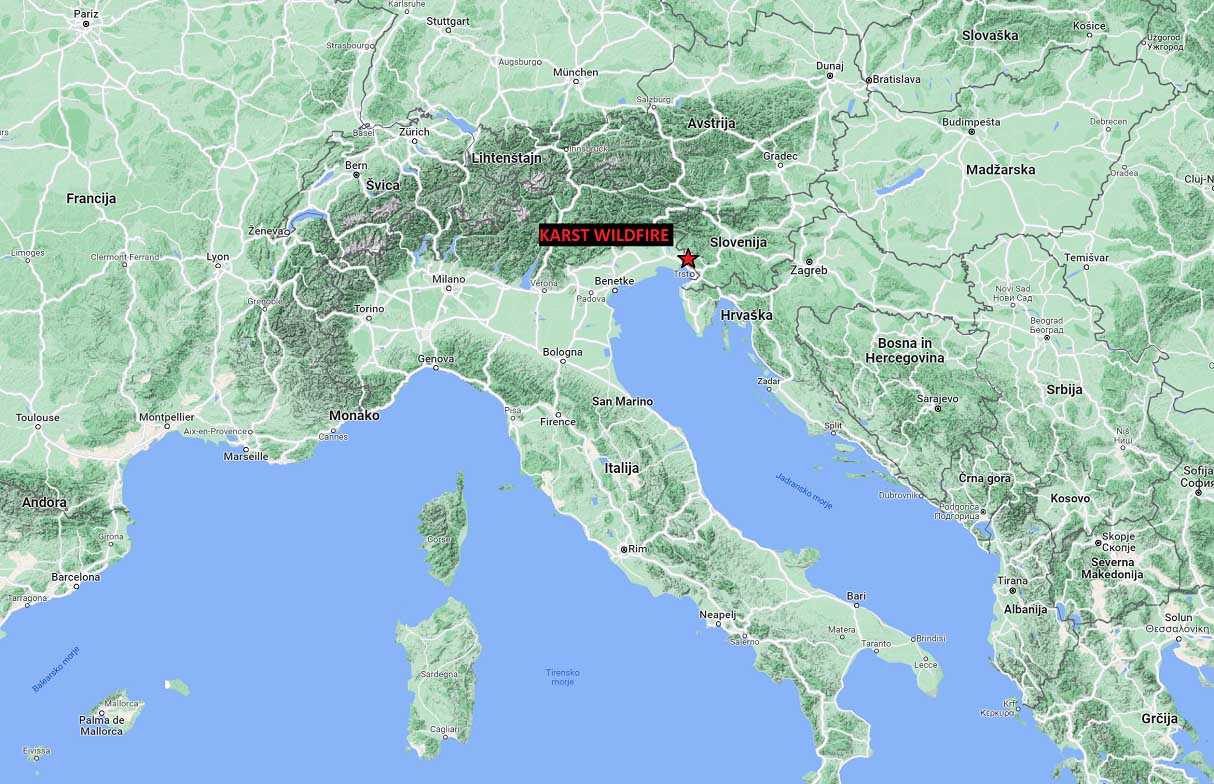
The plateau lies between the Vipava Valley, the low hills surrounding the valley, the westernmost part of the Brkini Hills, northern Istria, and the Gulf of Trieste. The border between Italy and Slovenia crosses the western edge of the plateau.
The Karst plateau rises quite steeply above the neighboring landscape, the steepness is less pronounced on its northeastern side. The plateau gradually descends from the southeast to the southwest.
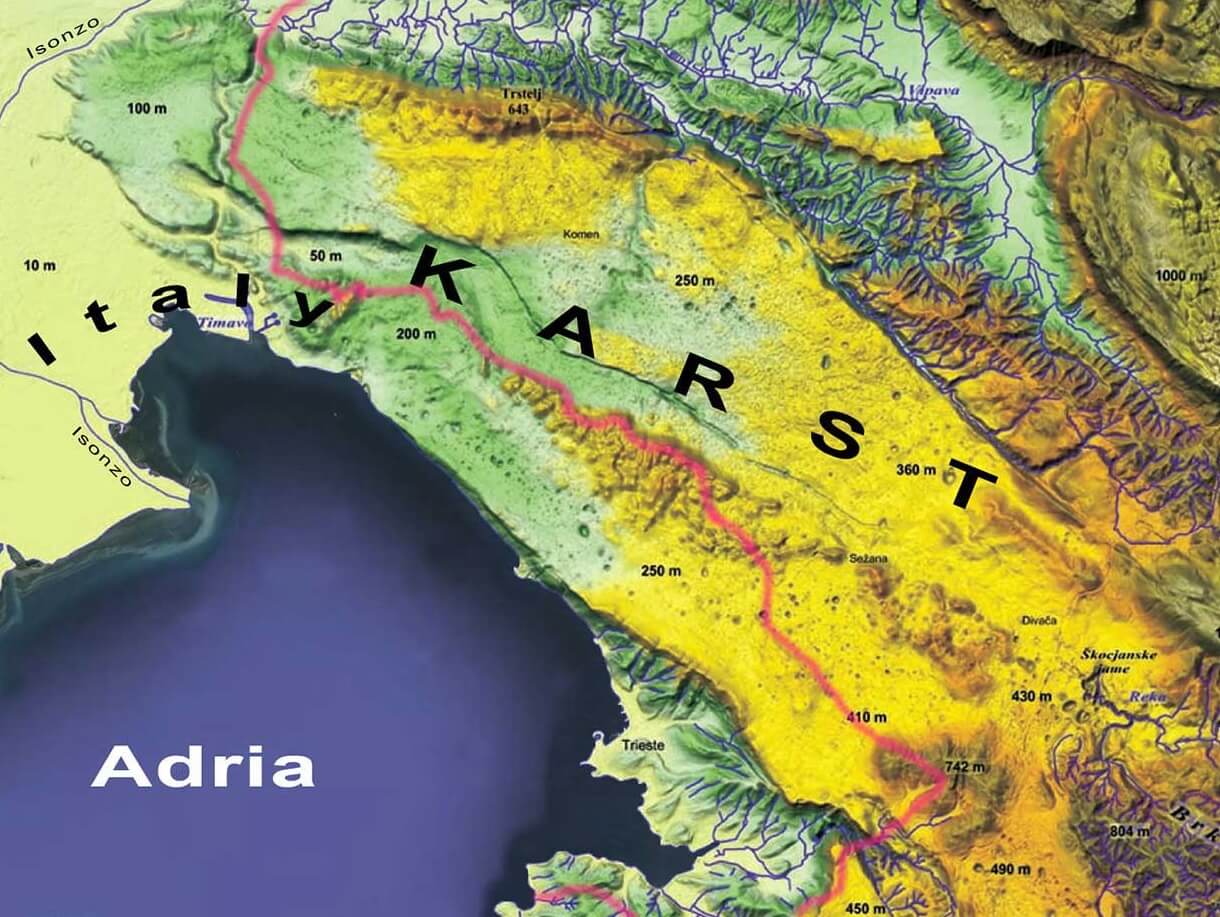
On average it lies 334 m above sea level. Its western edge, known as the Karst Rim (in Slovene: Kraški rob), is a continuation of the Učka mountain range in eastern Istria. The Rim rises to the east and southeast of Trieste, ending in steep cliffs between Aurisina and Duino. Many interesting geological phenomena occur along the Karst Rim, including the picturesque Rosandra Valley (also known as Glinščica).
Climate-wise, the Karst region is less exposed to the beneficial climatological effects of the Mediterranean due to its steeply descending slopes towards the Adriatic Sea. However, these slopes are, on the other hand, accelerating wind flow from the northern Adriatic region inland into western Slovenia.
And these winds were the trigger for explosive fire fronts in this historic wildfire event every day. Drought is extreme, the heatwave is at its peak, and fire conditions are at an exceptional level.
HISTORIC WILDFIRE FOR SLOVENIA
Summer 2022 is undoubtedly challenging the worst summer so far, that was 2003. The main difference this year is that we are facing a tremendous amount of drought across many parts of western, central, and southern Europe. Including record-breaking heatwave events. And huge wildfires are underway across the Iberian peninsula, France towards Benelux, as well as across Italy and Balkan peninsula countries.
While firefighters in France and Spain were still battling widespread fires, conditions are there finally improving as the worst of the heatwave has moved east. Brought some much-needed rain and also lower temperatures.

Remember there was well above 45 °C in Spain and Portugal less than two weeks ago, in the low to mid-40s in parts of France. And heatwave was ongoing since June. Officials have said they will probably be able to declare the fires completely extinguished within weeks if this weather pattern persists.
Meanwhile in Slovenia, the officials reported the raging blaze in the southwestern Karst region was out of control this past week. The fire frontline and smoke cloud were very large, clearly visible from space.
Attached below is the Copernicus satellite Sentinel 2 image.
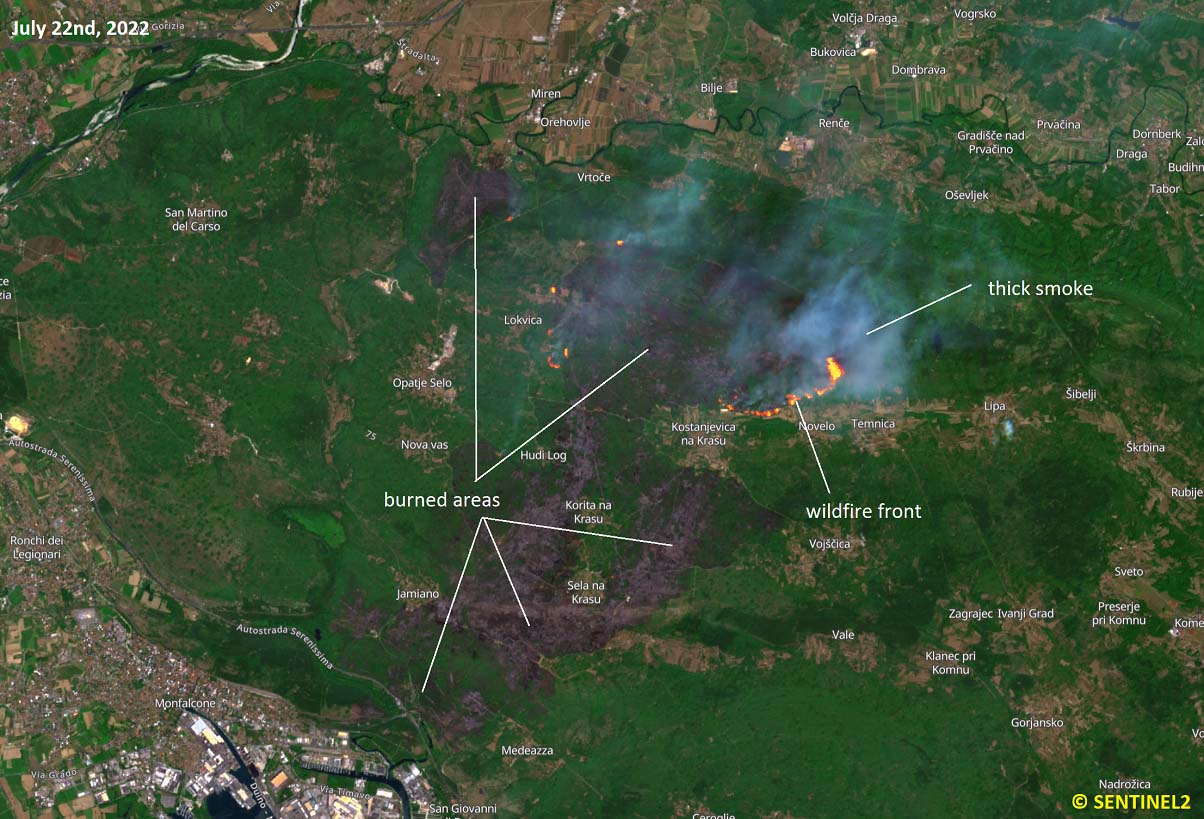
It has become the biggest wildfire on record since the country became an independent nation in 1991.
The fire has engulfed more than 3,500 hectares (nearly 9,000 acres) and set off unexploded ordnance left over from World War I.
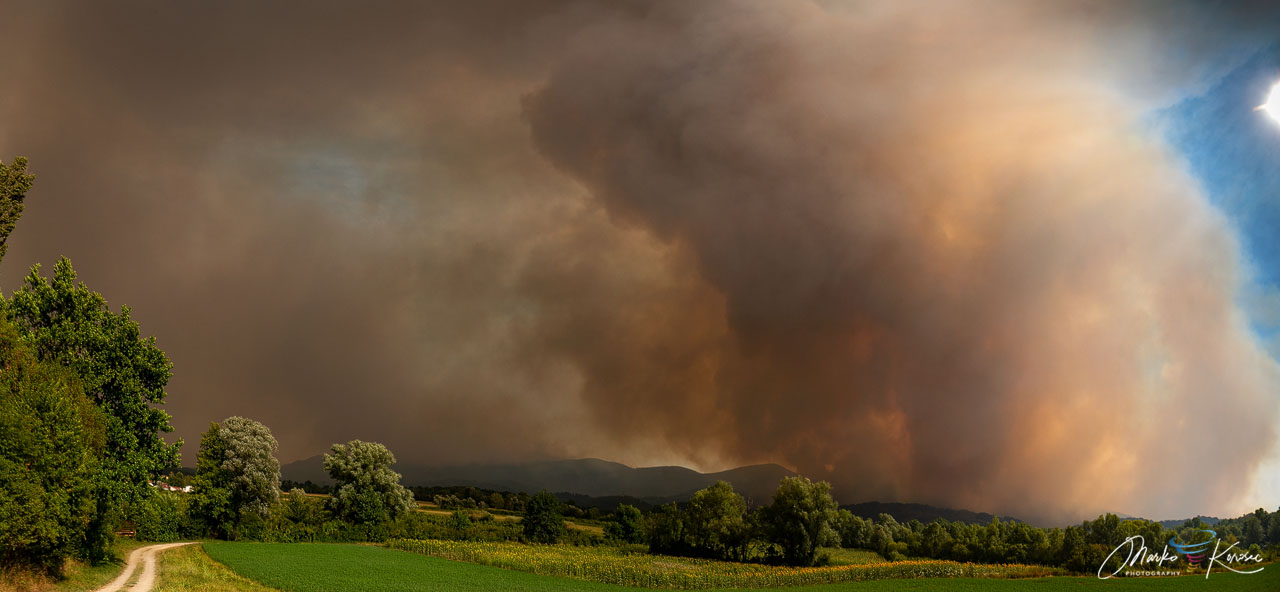
Photograph by Marko Korošec
More than 1,500 firefighters have been fighting the blaze, aided by the Slovenian army and police, as well as helicopters and planes from Austria, Italy, Hungary, Serbia, Slovakia, and Croatia.
Including two C-27J Spartan airplanes from Romania.
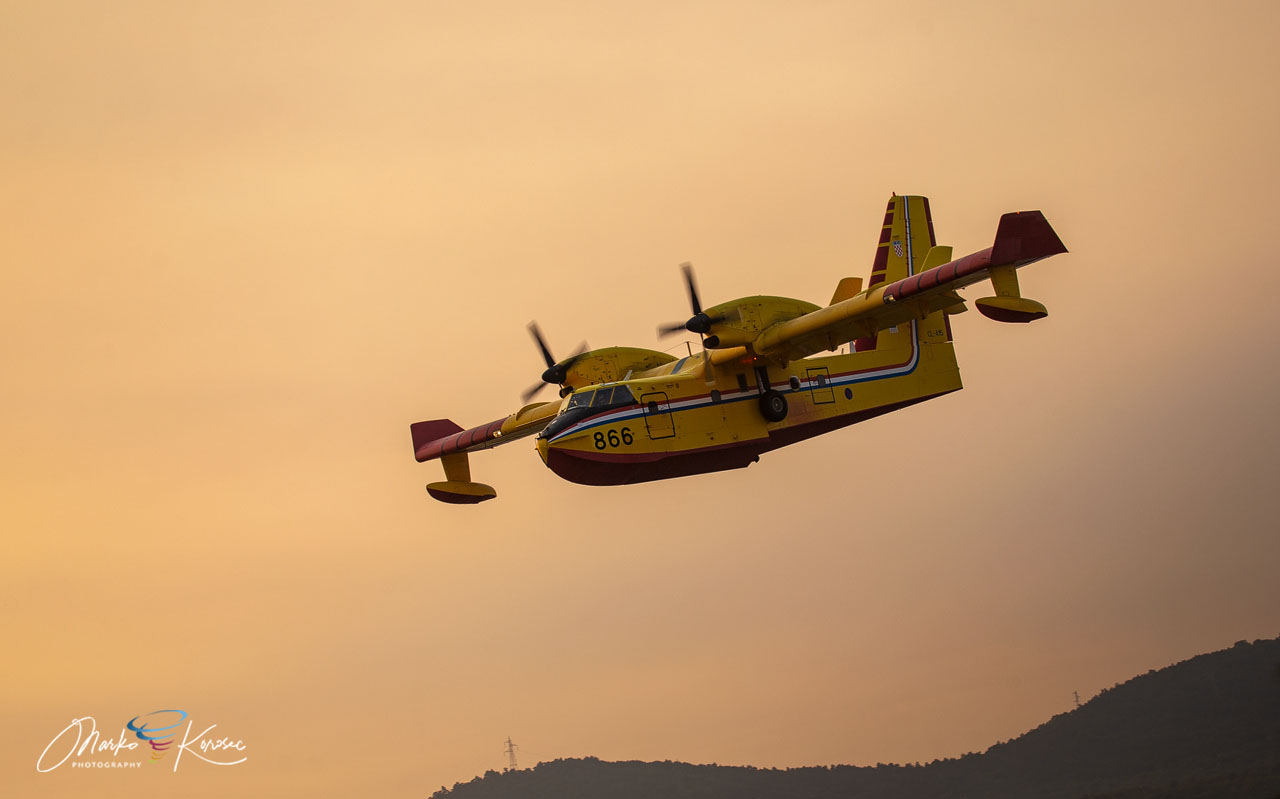
Photograph by Marko Korošec
The emergency crews are responding to multiple wildfires burning in the Karst region in Slovenia and Friuli Venezia Giulia Region in Italy. The main wildfire, known as The Carso Fire in Italy started on July 19th and was located between the cities Gorizia and Trieste. Authorities temporarily closed portions of the A4 motorway between Sistiana and Redipuglia due to thick smoke and low visibility, the road reopened on the afternoon of July 21st.
The closest Trieste Airport (TRS) was, however, operating normally as winds were blowing the smoke away from the runway. Also, the train services between Monfalcone and Bivio d’Aurisina were suspended for a couple of days. Several villages were also evacuated on the Italian side of the border.
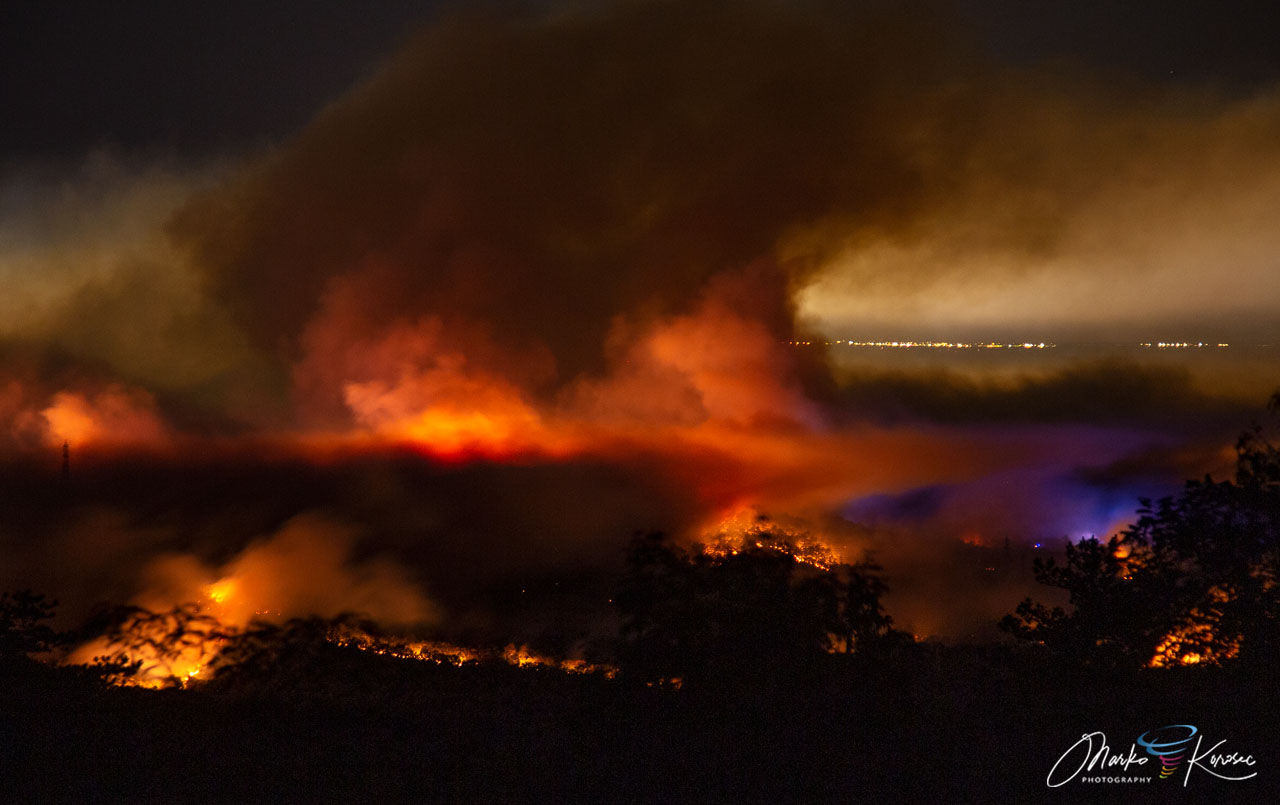
Photograph by Marko Korošec
The photograph above (taken from Sela na Krasu) is indicating the nighttime of the wildfire on the July 19th late night, located along the national border. The next days, July 20th, the enhanced westerly winds pushed the fire into the Slovenian side and the fires were out of control very soon.
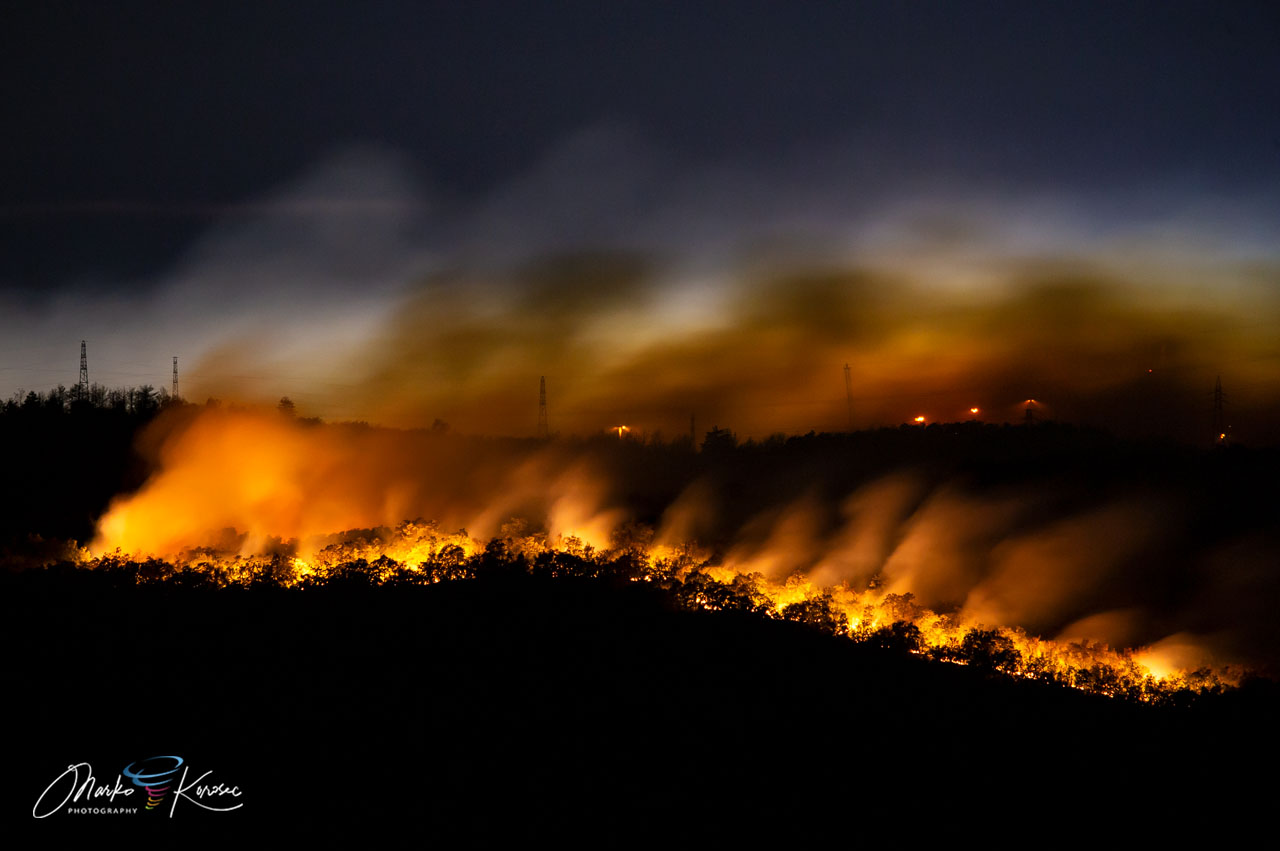
Photograph by Marko Korošec
Winds were blowing uphill into higher elevations of Karst plateau towards Opatje Selo and Sela na Krasu, several towns were evacuated during the day.
At times, the fires were so intense, that they formed pyrocumulus clouds. It is also known as the fire cloud, a dense cumuliform cloud associated with an intense wildfire or volcanic eruption. As per the WMO cloud atlas classification, it is known as a flammagenitus cloud.

Photograph by Marko Korošec
With multiple large wildfires burning in the western portions of the region, between Sela na Krasu, Miren, and Vojscica villages and later on between Cerje and Trstelj. On almost every day, authorities temporarily evacuated residents from villages including Novelo, Temnica, Vojscica, Miren, Vrtoče, Opatje Selo, and a few others.
Most of the residents were allowed to return home in the evening hours, as firefighters managed to stop blazes before reaching residents’ buildings.
The blazing wildfires have also set off unexploded ordnance left over from the First World War. Authorities removed a hundred pieces of unexploded ordnance from the burned areas. During the blazes crossing these areas, huge explosions were heard from these grenades. For this reason, hundreds of firefighter crews were not allowed to battle the fire at its core, as the threat of injuries was too high.
The main support came from the aircrews, with helicopters and Canadair planes.

Photograph by Marko Korošec
The extremely explosive nature of blazes spreading on the 21st of July has been a rough example of these explosions. One of the photographs below reveals such a huge blast of blazes after grenades were blown off, helping the fires to spread even faster as winds sent sparks further downwind from the main fire-front line.

Photograph by Marko Korošec
Due to thick smoke spread tens of kilometers away from the Karst wildfire, authorities have advised residents in the Koper, Nova Gorica, and Postojna municipalities (as well as along the Italian side of the Karst region) to avoid excessive physical activity and to stay in closed air-conditioned areas due to the low air quality as a result of the fire.
The satellite image sequence below indicated how the smoke cloud was moving for several days across the North Adriatic region, northeast Italy, and western Slovenia.
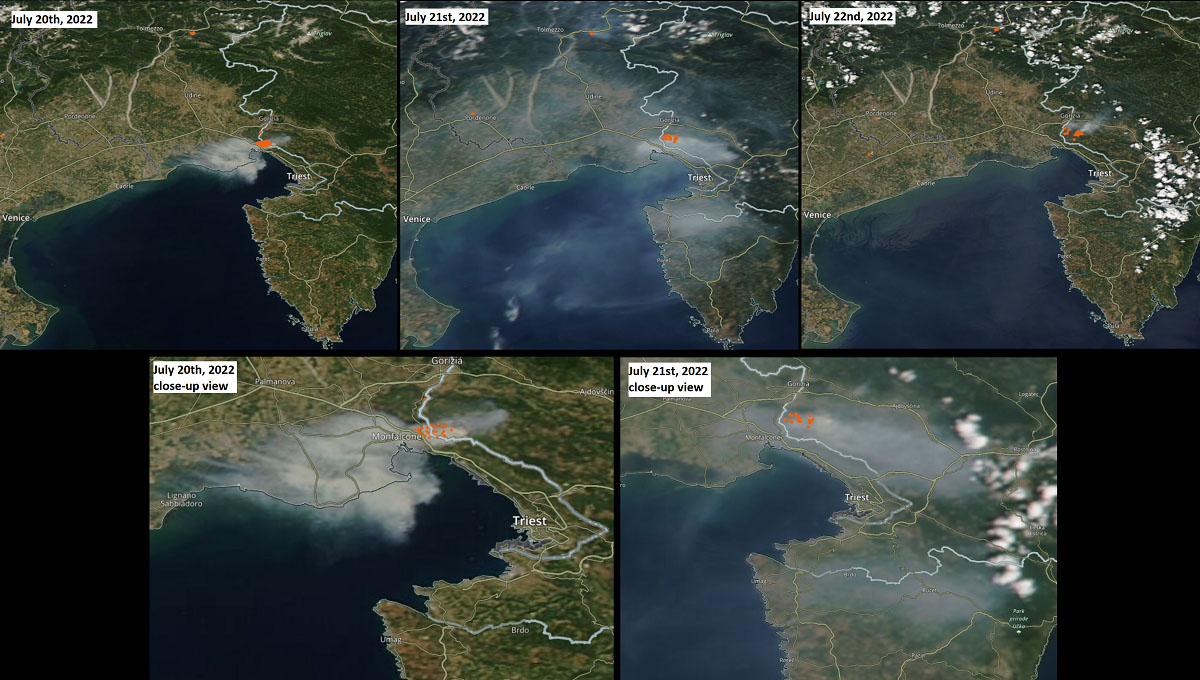
As of July 24th, wildfires were finally under control, thanks to a huge amount of work done by aircrews and indeed ground personnel doing forest cuts and watering the areas along the road to stop the fires to advance further. Despite high temperatures and winds still strong over the weekend, the situation is improving.
However, the weather forecast for the upcoming days and weeks is not too optimistic. There is some chance of rain for the region on Tuesday and Wednesday, but severe drought with likely to continue into the next month. Therefore, additional wildfire growth is likely to occur.
WHAT’S NEXT? HEATWAVE AND WILDFIRE THREAT IS FORECAST TO LIKELY CONTINUE INTO AUGUST 2022
The general weather pattern over the central part of Europe is forecast to remain more or less similar for the remainder of July, with a frontal system crossing the Alpine region, northern Italy, and Slovenia between Tuesday and Wednesday. Some rain could be possible as well, although it won’t be enough to stop the ongoing drought and extremely dry conditions, any rain is much-appreciated for the wildfire area these days.
From the animation above, we can see the ongoing temperature picture forecast over Europe, expressing the above-normal temperatures and heatwave spread across the southern portions of the continent. The general pattern is more or less repeating itself, with blocking High and excessive heat extending into early August 2022.
Images used in this article were provided by Wxcharts, Copernicus EU, and NOAA.